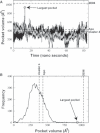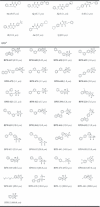Applying molecular dynamics simulations to identify rarely sampled ligand-bound conformational states of undecaprenyl pyrophosphate synthase, an antibacterial target
- PMID: 21294851
- PMCID: PMC3095679
- DOI: 10.1111/j.1747-0285.2011.01101.x
Applying molecular dynamics simulations to identify rarely sampled ligand-bound conformational states of undecaprenyl pyrophosphate synthase, an antibacterial target
Abstract
Undecaprenyl pyrophosphate synthase is a cis-prenyltransferase enzyme, which is required for cell wall biosynthesis in bacteria. Undecaprenyl pyrophosphate synthase is an attractive target for antimicrobial therapy. We performed long molecular dynamics simulations and docking studies on undecaprenyl pyrophosphate synthase to investigate its dynamic behavior and the influence of protein flexibility on the design of undecaprenyl pyrophosphate synthase inhibitors. We also describe the first X-ray crystallographic structure of Escherichia coli apo-undecaprenyl pyrophosphate synthase. The molecular dynamics simulations indicate that undecaprenyl pyrophosphate synthase is a highly flexible protein, with mobile binding pockets in the active site. By carrying out docking studies with experimentally validated undecaprenyl pyrophosphate synthase inhibitors using high- and low-populated conformational states extracted from the molecular dynamics simulations, we show that structurally dissimilar compounds can bind preferentially to different and rarely sampled conformational states. By performing structural analyses on the newly obtained apo-undecaprenyl pyrophosphate synthase and other crystal structures previously published, we show that the changes observed during the molecular dynamics simulation are very similar to those seen in the crystal structures obtained in the presence or absence of ligands. We believe that this is the first time that a rare 'expanded pocket' state, key to drug design and verified by crystallography, has been extracted from a molecular dynamics simulation.
© 2011 John Wiley & Sons A/S.
Figures







Similar articles
-
Molecular insights into substrate binding mechanism of undecaprenyl pyrophosphate with membrane integrated phosphatidyl glycerophosphate phosphatase B (PgpB) using molecular dynamics simulation approach.J Biomol Struct Dyn. 2019 Mar;37(4):1062-1089. doi: 10.1080/07391102.2018.1449666. Epub 2018 Mar 28. J Biomol Struct Dyn. 2019. PMID: 29528805
-
Crystal structures of undecaprenyl pyrophosphate synthase in complex with magnesium, isopentenyl pyrophosphate, and farnesyl thiopyrophosphate: roles of the metal ion and conserved residues in catalysis.J Biol Chem. 2005 May 27;280(21):20762-74. doi: 10.1074/jbc.M502121200. Epub 2005 Mar 23. J Biol Chem. 2005. PMID: 15788389
-
Discovery and structural characterization of an allosteric inhibitor of bacterial cis-prenyltransferase.Protein Sci. 2015 Jan;24(1):20-6. doi: 10.1002/pro.2579. Epub 2014 Nov 6. Protein Sci. 2015. PMID: 25287857 Free PMC article.
-
A Slippery Scaffold: Synthesis and Recycling of the Bacterial Cell Wall Carrier Lipid.J Mol Biol. 2020 Aug 21;432(18):4964-4982. doi: 10.1016/j.jmb.2020.03.025. Epub 2020 Mar 29. J Mol Biol. 2020. PMID: 32234311 Review.
-
Deciphering the metabolism of undecaprenyl-phosphate: the bacterial cell-wall unit carrier at the membrane frontier.Microb Drug Resist. 2014 Jun;20(3):199-214. doi: 10.1089/mdr.2014.0035. Epub 2014 May 5. Microb Drug Resist. 2014. PMID: 24799078 Free PMC article. Review.
Cited by
-
Reducing the Level of Undecaprenyl Pyrophosphate Synthase Has Complex Effects on Susceptibility to Cell Wall Antibiotics.Antimicrob Agents Chemother. 2013 Sep;57(9):4267-4275. doi: 10.1128/AAC.00794-13. Epub 2013 Jun 24. Antimicrob Agents Chemother. 2013. PMID: 23796923 Free PMC article.
-
Role of Computational Methods in Going beyond X-ray Crystallography to Explore Protein Structure and Dynamics.Int J Mol Sci. 2018 Oct 30;19(11):3401. doi: 10.3390/ijms19113401. Int J Mol Sci. 2018. PMID: 30380757 Free PMC article. Review.
-
Undecaprenyl diphosphate synthase inhibitors: antibacterial drug leads.J Med Chem. 2014 Jul 10;57(13):5693-701. doi: 10.1021/jm5004649. Epub 2014 Jun 24. J Med Chem. 2014. PMID: 24827744 Free PMC article.
-
Functional Protein Dynamics in a Crystal.bioRxiv [Preprint]. 2024 Mar 24:2023.07.06.548023. doi: 10.1101/2023.07.06.548023. bioRxiv. 2024. Update in: Nat Commun. 2024 Apr 15;15(1):3244. doi: 10.1038/s41467-024-47473-4. PMID: 37461732 Free PMC article. Updated. Preprint.
-
Worth the Weight: Sub-Pocket EXplorer (SubPEx), a Weighted Ensemble Method to Enhance Binding-Pocket Conformational Sampling.J Chem Theory Comput. 2023 Sep 12;19(17):5677-5689. doi: 10.1021/acs.jctc.3c00478. Epub 2023 Aug 16. J Chem Theory Comput. 2023. PMID: 37585617 Free PMC article.
References
-
- Rohdich F, Bacher A, Eisenreich W. Isoprenoid biosynthetic pathways as anti-infective drug targets. Biochem Soc Trans. 2005;33:785–791. - PubMed
-
- Ko TP, Chen YK, Robinson H, Tsai PC, Gao YG, Chen AP, Wang AH, Liang PH. Mechanism of product chain length determination and the role of a flexible loop in Escherichia coli undecaprenyl-pyrophosphate synthase catalysis. J Biol Chem. 2001;276:47474–47482. - PubMed
Publication types
MeSH terms
Substances
Grants and funding
LinkOut - more resources
Full Text Sources
Other Literature Sources
Medical
Molecular Biology Databases

